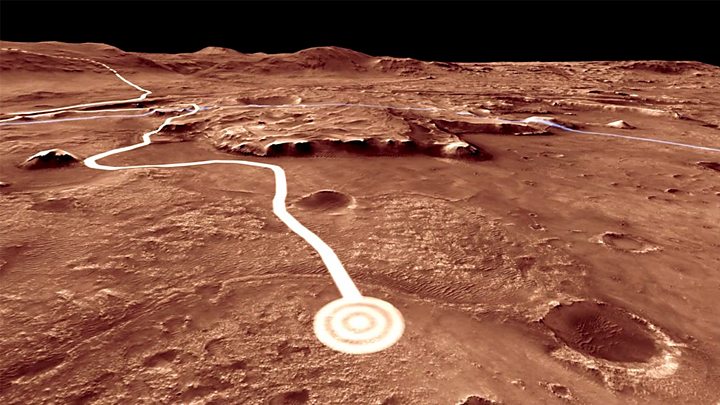
Image copyright
NASA / JPL-Caltech
On 20 July, Nasa will get its first opportunity to launch the Perseverance rover to Mars. Here, we answer some common questions about the mission.
What will the rover do?
The Perseverance rover will land on Mars to search out signs of past microbial life, if it ever existed. It will be the first Nasa mission to hunt directly for these “biosignatures” since the Viking missions in the 1970s.
The rover will collect samples of rock and soil, encase them in tubes, and leave them on the planet’s surface for return to Earth at a future date. Perseverance will also study Martian geology and test out a way for future astronauts to produce oxygen for breathing and fuel from CO2 in the atmosphere.
In addition, a drone-like helicopter will be deployed to demonstrate the first powered flight on Mars. Perseverance will explore Mars’ Jezero Crater for at least one Martian year (about 687 Earth days).
How does it get to Mars?
Image copyright
NASA / C. MANGANO
The one-tonne, car-sized rover is scheduled to launch from Cape Canaveral Air Force Station in Florida on an Atlas 5 rocket between 20 July and 11 August 2020. Perseverance travels to Mars enclosed in a protective aeroshell consisting of two parts: a conical backshell and a curved heat shield.
The aeroshell is connected to a cruise stage that fires thrusters to keep the spacecraft on course, ensuring it arrives at Mars in the right place for landing. Perseverance will make its seven-minute descent to the Martian surface on 18 February 2021.
The relative positions of Earth and Mars mean that launch opportunities come up only every 26 months. If Perseverance didn’t launch to Mars this summer, the mission would have to wait until September 2022 to try again.
Technical specs: Perseverance rover
- Length: 3m (10ft)
- Width: 2.7m (9ft)
- Height: 2.2m (7ft)
- Weight: 1,025kg (2,260lbs)
- Power source: Multi-Mission Radioisotope Thermoelectric Generator (MMRTG). Converts heat from the radioactive decay of plutonium into electricity
How does Perseverance land?
Image copyright
NASA / JPL-Caltech
As the spacecraft ploughs through the Martian atmosphere, its heat shield will have to endure temperatures as high as 2,100C (3,800F). When it’s about 11km (7mi) above the ground, the spacecraft will deploy a parachute, slowing the heaviest payload in the history of Mars exploration from a speed of Mach 1.7 (2,099 km/h; 1,304 mph) to about 320 km/h (200 mph).
The heat shield subsequently drops away from the backshell and, for a short time, the rover – which is attached to a descent stage – falls freely towards the ground.
Eight retrorockets on the descent stage then fire, allowing the “sky crane” manoeuvre to be performed. Perseverance is lowered slowly on three nylon ropes and an “umbilical cord”. When the rover’s wheels touch the ground, the tethers are severed and the descent stage flies to a safe distance.
Where on Mars will it be exploring?
Image copyright
NASA / JPL-Caltech / MSSS / JHU-APL/ESA
The rover’s target is a 49km (30 mi) -wide impact depression just north of Mars’ equator. More than 3.5 billion years ago, scientists think, river channels spilled over the wall of Jezero Crater to form a lake.
The large bowl is also home to one of the best preserved Martian examples of a delta, a sedimentary structure that forms when rivers enter open bodies of water and deposit rocks, sand and – potentially – organic carbon in layers.
Image copyright
NASA/JPL/JHUAPL/MSSS/BROWN UNIVERSITY
Microbes could have lived in the crater when water was there. Jezero preserves a record of important geological processes such as impact cratering and volcanism, as well as the action of water. Studying its rocks will shed light on how the planet evolved over time.
How does the rover search for signs of past life?
Jezero’s fan-shaped delta is one of the prime targets in the hunt for signs of past life. Scientists also see carbonate minerals deposited around the crater’s shoreline like the ring in a bathtub. When carbonates precipitate out of water, they can trap things that are in it, including evidence of life.
Image copyright
Science Photo Library
“We’ll be searching for biosignatures – patterns, textures or substances that require the influence of life to form,” says deputy project scientist Katie Stack Morgan.
We don’t know what Martian biosignatures might look like, but the ancient Earth might provide clues. A record of our planet’s early life can be found in stromatolites, rocks originally formed by the growth of layer after layer of bacteria. If similar structures exist on Mars, scientists could combine measurements from different instruments to assess the likelihood of a biological origin.

Media playback is unsupported on your device
Why do scientists think there could have been life on Mars?
Today, Mars is cold and dry, with a thin atmosphere that exposes the surface to harmful levels of cosmic radiation. But billions of years ago, the planet appears to have been wetter, with a thicker atmosphere. Multiple lines of evidence, such as the presence of mudstones and sedimentary bands, show that there was once liquid water on the surface.
This is important because water is an essential ingredient for all life on Earth. Curiosity also found organic molecules preserved in three-billion-year-old sedimentary rocks. While tantalising, it’s not clear whether these organics preserve a record of ancient life, were their food, or have nothing to do with biological processes.
What instruments is the rover carrying?
Image copyright
NASA / JPL-Caltech
Perseverance is carrying an advanced payload of science instruments to gather information about Mars’ geology, atmosphere, environmental conditions and potential biosignatures:
- Mastcam-Z: An advanced camera system to help study surface minerals
- MEDA: A Spanish-built sensor suite to measure temperature, wind speed and direction, pressure, humidity and dust
- MOXIE: Experiment to demonstrate how astronauts might produce oxygen from Martian CO2 for breathing and fuel
- PIXL: Has an X-ray spectrometer to identify chemical elements and a camera that takes close-up images of rock and soil textures
- RIMFAX: A Norwegian-built ground-penetrating radar that will map geology beneath the surface at centimetre scales
- SHERLOC: Will use spectrometers, a laser and camera to hunt for organics and minerals that were altered by water
- SuperCam: Will examine rock and soil with a camera, laser and spectrometers to look for organic compounds
Why fly a helicopter on Mars?
Image copyright
NASA / JPL-Caltech
Ingenuity is a 1.8kg (4lb) helicopter that will ride to Mars attached to the belly of Perseverance. Nasa wants to demonstrate powered flight in Mars’ thin atmosphere. The Red Planet’s gravity is lower (about one-third that of Earth’s), but its atmosphere is just 1% the density of Earth’s. This makes it harder to generate the lift required to get off the ground.
Equipped with two counter-rotating blades, the autonomous helicopter can take colour images with a 13-megapixel camera, the same type commonly found in smartphones. Rotorcraft could be a useful way to explore other worlds: flying vehicles travel faster than ground-based rovers, and can reach areas that are inaccessible to wheeled vehicles.
How does this rover differ from Curiosity?
Image copyright
NASA / Kim Shiflett
Perseverance is very similar to its predecessor Curiosity in terms of overall design, but there are key differences. As well as the new science payload, Perseverance has a larger “hand”, or turret, on the end of its robotic arm to hold a heavier suite of tools, including a coring drill.
The system designed to cache samples is also a new feature. Engineers have re-designed the rover’s wheels to make them more resistant to wear and tear. Curiosity’s wheels sustained damage from driving over sharp, pointed rocks.
How does the rover store rocks and soil?
The rover’s Sample Caching System is composed of three robotic elements. The most visible is the 2.1m (7ft) -long, five-jointed robotic arm, which is bolted to the chassis. A rotary percussive drill on the arm’s turret is able to cut out intact cores of Martian rock. These cores – about the size of a piece of chalk – go into a sample tube. The main robot arm then places the filled tube on a mechanism at the front of the rover called the bit carousel.
This mechanism, which recalls a 1960s slide projector, moves the tube inside the rover where a smaller, 0.5m (1.6ft) -long sample handling arm (also called the T. rex arm) grabs it. An image is taken before the tube is hermetically sealed and placed in a storage rack. It’s driven around on the rover until the team finds a suitable place to drop it off.
How will the Martian samples be delivered to Earth?
Image copyright
ESA / ATG Medialab
For decades, scientists have wanted to deliver samples of Martian rock and soil to Earth for study in laboratories. Here, scientists could investigate the samples with instruments too large and complex to send to Mars. By leaving rock and soil samples on the surface in sealed tubes, Perseverance will lay the groundwork for that to happen.
As part of the programme known as Mars Sample Return, a separate mission will be sent to land on Mars to pick up the tubes using a “fetch” rover. A robotic arm will then transfer the tubes from the fetch rover into a rocket called the Mars Ascent Vehicle (MAV). The ascent vehicle blasts the samples into Martian orbit where they are captured by an orbiter. This orbiter will then deliver the sample containers to Earth, possibly by 2031.
Follow Paul on Twitter.
Read MoreFeedzy


